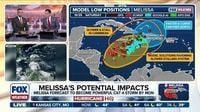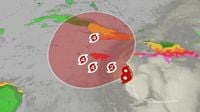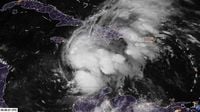Tropical Storm Melissa, the thirteenth named storm of the 2025 Atlantic hurricane season, is turning into a major threat for Jamaica, Haiti, and the wider Caribbean as it churns slowly through some of the warmest ocean waters on the planet. As of Friday, October 24, 2025, forecasters warned that Melissa’s sluggish pace and the region’s saturated ground could set the stage for catastrophic flooding, landslides, and widespread disruption over the coming days.
According to the U.S. National Hurricane Center (NHC), Melissa was nearly stationary over the north-central Caribbean Sea on Friday morning, centered about 150 miles southeast of Kingston, Jamaica, and 270 miles southwest of Port-au-Prince, Haiti. The storm packed maximum sustained winds of 45 mph and was inching north at just 3 mph. This slow movement is particularly alarming, as it means rain will continue to fall over the same areas for days, compounding flood risks and increasing the potential for disaster.
"The rainfall is a huge risk with the storm," Michael Brennan, director of the U.S. National Hurricane Center in Miami, told the Associated Press. "Rainfall has historically been the biggest cause of loss of life of tropical storms and hurricanes in the Caribbean."
Forecasters expect Melissa to rapidly intensify into a hurricane by Saturday, with the potential to become a Category 4 storm by Tuesday. This explosive strengthening is fueled by the Caribbean’s exceptionally warm waters, which run deep and prevent the usual cooling effect that can weaken hurricanes. Meteorologists say that, as a result, Melissa could become one of the most destructive storms of the season for Jamaica and its neighbors.
Jamaica and western Haiti are already under a hurricane watch, while tropical storm warnings are in effect across the region. Jamaica’s eastern region could see up to 14 inches (36 centimeters) of rain through the weekend—totals that could climb even higher if the storm lingers. The ground in these areas is already saturated from recent heavy rains, making flooding and landslides almost inevitable. The NHC has been explicit in its warnings for Jamaica: "Due to Melissa’s slow motion, the risk of a prolonged multi-day period of potentially damaging winds, heavy rainfall resulting in life-threatening flash flooding and numerous landslides, and storm surge continues to increase for Jamaica."
The government in Jamaica is taking no chances. Schools, health centers, and government offices across the island closed on Thursday, with authorities warning that all airports would shut within 24 hours if a hurricane warning is issued. Public hospitals have been in “emergency mode” since Thursday evening, according to Christopher Tufton, Jamaica’s Minister of Health and Wellness. This move halts outpatient and elective procedures to ensure beds are available for emergencies. Daryl Vaz, Minister of Science, Energy, Telecommunications and Transport, confirmed that airports remain open for now but will likely close quickly if conditions worsen.
Matthew Samuda, Jamaica’s minister of economic growth and job creation, underscored the urgency: "The situation is indeed serious. Be very attentive, because it can change in a moment’s notice."
In Haiti, the storm’s impact has already been tragic. At least three deaths have been reported, including an elderly man killed by a falling tree in Marigot, southern Haiti, and five others injured in the central Artibonite area due to flooding, according to the Haitian Civil Protection Agency and reports from Reuters. The United Nations announced on Thursday that it was preparing more than 100 emergency shelters in Haiti’s southern region, bracing for more devastation in a country already struggling with erosion, poverty, and gang violence—factors that make storm preparation and recovery especially difficult.
The Dominican Republic has not been spared, either. Melissa knocked out dozens of water supply systems, leaving more than half a million people without water. The storm also brought down trees, toppled traffic lights, and triggered several small landslides. All public schools across the Dominican Republic closed on Friday, and government offices in 12 provinces under alert followed suit. Juan Manuel Méndez García, the country’s emergency operations director, stressed the seriousness of the situation: "This is an event that we should be following minute by minute." He noted that evacuations in areas under alert were mandatory.
The slow-moving nature of Melissa is what makes it particularly dangerous. When storms crawl, rainfall accumulates over the same towns for days, dramatically increasing the risk of catastrophic flooding. Meteorologists point to past disasters, such as Hurricane Harvey in Texas (2017) and Hurricane Dorian in the Bahamas (2019), as examples of what can happen when a tropical system stalls over land.
Adding to the concern, the region’s mountainous terrain—especially in Haiti, Jamaica, and the Dominican Republic—will force air upward, squeezing even more moisture out of the storm and turning tropical humidity into torrents racing downhill. Mudslides, experts say, are all but guaranteed in this scenario.
There’s also the issue of the storm’s track. While Melissa is currently expected to pass near or just south of Jamaica, there’s still uncertainty in the forecast. If the storm turns north sooner than expected, Haiti could bear the brunt of the rainfall and wind. If it lingers farther south, Jamaica could face a prolonged assault of hurricane conditions. Either way, both countries—and potentially Cuba, the Cayman Islands, and the Bahamas—must remain on high alert.
Melissa is the first named storm to form in the Caribbean this year. The U.S. National Oceanic and Atmospheric Administration (NOAA) had predicted an above-normal Atlantic hurricane season, with 13 to 18 named storms, five to nine hurricanes, and two to five major hurricanes (Category 3 or higher). As of Friday, Melissa was the thirteenth named storm and is on track to become a major hurricane by the end of the weekend.
Jamaica, which suffered significant damage from Hurricane Beryl in 2024, faces a different threat this time. Unlike Beryl, which moved past the island quickly, Melissa’s slow pace means residents should prepare for a multi-day ordeal of wind, rain, and potential storm surge. Preparations to protect life and property should be underway, as weather conditions are expected to deteriorate rapidly by Saturday morning.
Looking ahead, the United States mainland is not entirely out of danger, though a direct hit appears unlikely. If Melissa’s northward turn is delayed, eastern Cuba or the Bahamas could find themselves in the storm’s path before it eventually curves into the Atlantic. Even without landfall, rough surf and rip currents could affect the U.S. East Coast next week.
As the weekend unfolds, all eyes are on Melissa’s path and intensity. The Caribbean’s deep, warm waters and the storm’s sluggish movement set the stage for a potentially historic and destructive event. Residents across the region are urged to heed official warnings, prepare for the worst, and remain vigilant as Melissa’s threat grows by the hour.
With the memory of past storms still fresh and the forecast growing more concerning, the Caribbean braces for what could become one of the most punishing hurricanes of the season—one that will test the region’s resilience and resolve yet again.






